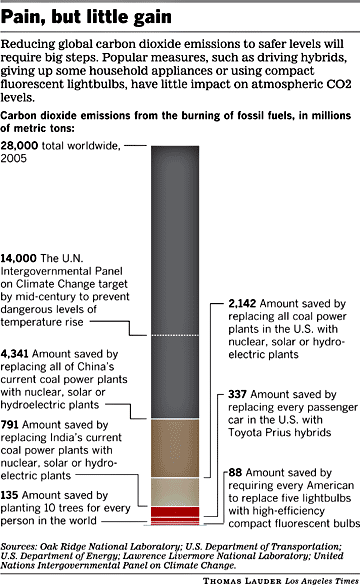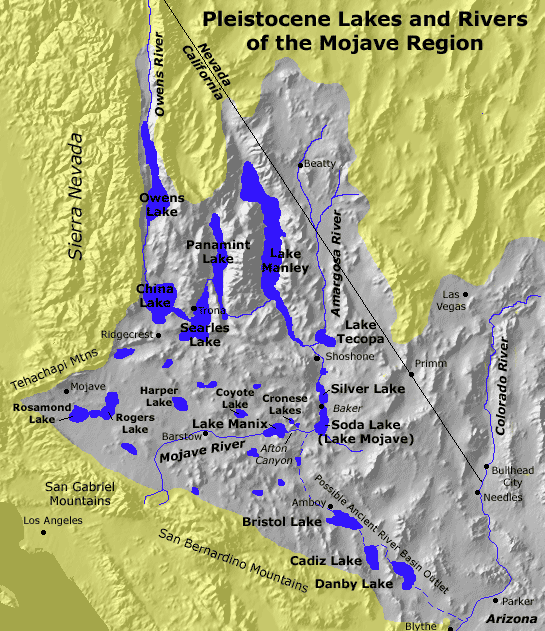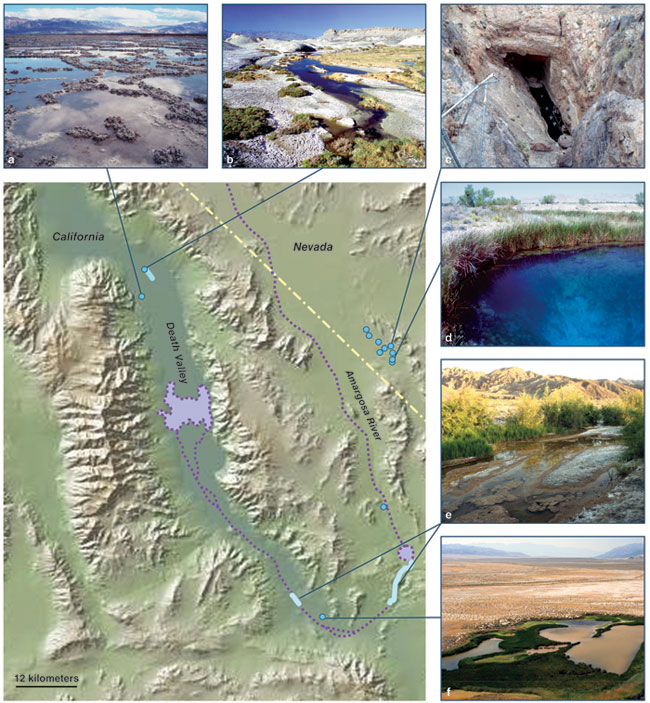
Here's the view from our guest bedroom window — raindrops on the papyrus plant:

December 9, 2007
That storm brought quite a bit of rain: it lasted a day
longer than predicted.
December 11, 2007
I've gotten curious about the Madrean sky islands on the border between the US and Mexico.
These "sky islands" are about 42 mountainous regions surrounded by the
the dry grasslands and shrub of the Chihuahuan and Sonoran deserts.
They serve as the homes for isolated ecosystems, much
like islands in the oceans. I first read about them here:
This graph illustrates the huge challenges involved:

However, it's more depressing than absolutely necessary!
There are better ways to tackle the problem of greenhouse gases.
For example, see the
carbon wedges of Pacala and Socolow, described in my
October 2nd diary
entry.
December 15, 2007
I avoid talking about major news stories on this diary. Major
news stories are, by definition, the stuff you're likely to have
already heard.
But, it's not often that international negotiations in a struggle to save our planet nearly collapse, run 20 hours overtime — and only end when the representative of the world's most powerful country is pressured by boos from the audience into signing a deal!
After a wrenchingly emotional drama, a climate agreement was signed in Bali: the Bali Roadmap. Listen to the story here:
You can watch videos of some of this:How the U.S. Caved at Bali
Brian Walsh
Time, December 15, 2007[...]
The two-week-long negotiations, meant to craft the beginnings of a new global effort on climate change, had already gone into overtime when diplomats emerged from behind closed doors at 2 AM Saturday morning, claiming that a compromise deal between the EU, the U.S. and the major developing nations had been reached. Delegates from some 190 nations reconvened several hours later for what should have been a final approval session.
But delegates from India and China unexpectedly objected to aspects of the text, including the degree of technical assistance poor nations would receive from the rich for low-carbon development. The impasse . the latest in several tortured days of negotiations — led Rachlat Witolear, the chair of the conference, to twice suspend the open session for further behind the scenes meetings, leading to a real fear that diplomats might leave the island without a final agreement.
It was only with the help of UN Secretary-General Ban Ki Moon, who made an emergency stop in Bali, that negotiations got kick started. The South Korean, in office for less than a year, is known as diplomatic even by UN standards, but he arrived without mincing words. "Frankly, I am disappointed at the lack of progress," said Ban to a packed audience. "Seize the moment, this moment, for the good of all humanity."
With that, Ban left the chamber to a standing ovation. Witolear reopened talks, and a representative from China turned to speak. His anger audible, he asked why the UN secretariat overseeing the meeting had earlier restarted the session while negotiators were still meeting away from the conference hall — essentially accusing the officials of acting unfairly towards the developing nations. For Yvo de Boer, the executive secretary of the United Nations Framework on Climate Change (UNFCCC) and the summit's guide, it was too much. Visibly exhausted by all-night negotiations, the Dutchman appeared to momentarily break down and fled the session, leaving a stunned audience in his wake.
But the real drama was to come. After India reiterated its objection — and was essentially supported by the European Union — the lead American negotiator Paula Dobiansky turned to speak, and announced that the U.S. would not accept India's changes, which sought to lighten the expectations from developing countries. (The UN negotiating process requires total consensus.) Boos rained on the U.S. delegation from NGO observers and even the press gallery, breaking the last remaining appearance of diplomatic placidity.
It's hardly the first time the U.S. has been jeered at a UN event, but what happened next was unique. Nation after developing nation rose to criticize the U.S. in language more often reserved for a political debate than a UN conference. A representative from tiny Papua New Guinea — one of many small island states most immediately threatened by climate change — recalled the old Lee Iacocca line about leading, following or getting out of the way. "If the U.S. will not lead, get out of the way," he said, to gallery cheers. "Please get out of the way."
More importantly, with the exception of a confused statement from Japan, not one of the allies that had generally stood with the U.S. the past two weeks — Australia, Russia, Canada — rose in its defense. The near-total isolation of the U.S. on climate change — which had been building since its rejection of the Kyoto Protocol nearly a decade ago — was now obvious, apparently even to the U.S. Dobiansky turned to speak. "We've listened very closely to many of our colleagues here during these two weeks, but especially to what has been said in this hall today," she said. "We will go forward and join consensus." Boos turned to cheers, and the deal was essentially sealed.
For the exhausted delegates — not to mention the journalists and environmentalists who had stayed through the night and the day following the negotiations — the simple elation at having reached an agreement was palpable. "In 20 years of doing this, I've never seen anything like this," marveled Alden Meyer, director of strategy and policy for the Union of Concerned Scientists (UCS).
The actual accomplishments are mixed. Some very bad news: the
European Union lost its bid to institute specific targets for cutting
the emission of greenhouse gases. Some good news: unlike the Kyoto
Protocol, the Bali Roadmap recognizes the importance of forests,
and tropical nations may eventually be rewarded for not cutting down
their forests.
December 18, 2007
Wanna see what DNA actually does? Check out these cool movies,
brought to my attention by Mike Stay:
This is a replisome in action! That's the piece of molecular machinery our cells use to duplicate their DNA. The speed of the process is realistic for actual human cells, in which the DNA replicates at a speed of 20-50 bases per second. The bacterial replisome works 10 times faster!
Some details were omitted to make the movie easier to understand. But, what you see is quite close to reality. Two tau subunits (shown in light blue here) connect the DNA helicase (dark blue) to a clamp loader (grey fingers). Each tau subunit also connects to one of the two DNA polymerase enzymes (purple). The other two proteins you see DNA clamps (green) and DNA primase (yellow-green), which adds RNA primers (yellow) to the single-strand DNA as it emerges from the helicase.
For more information and other views of the same scene, try the
WEHI-TV webpage.
December 19, 2007
Drive a few hours north of Riverside and you'll reach
one of the hottest, driest, harshest spots in the United States:
Death Valley.
Here temperatures soar above 49°C in the summer.
It's also the lowest place in the Western
Hemisphere: 86 meters below sea level at the bottom.
And, it's home to some of the world's toughest, most adaptable fish!
During the Pleistocene, Death Valley was filled by a huge lake, called Lake Manly:

Fish called "pupfish" entered from the Colorado River. But as the last ice age ended and the region warmed up and dried out, the lake split into many smaller lakes and marshes. Now the lake in Death Valley returns only when it rains — for example, during the huge rains of 2005. A few permanent ponds are fed by an underground aquifer, whose dwindling supplies of water are left over from the ice age. The pupfish struggle to survive, but separated in tiny habitats with different conditions, they have split into seven different species:

Two salt-tolerant species of pupfish live in Cottonball Marsh (a) and Salt Creek (b). A tiny water-filled cavern, Devil's Hole (c), holds its own species of pupfish. This is one of the rarest species known, with only 36 adults as of April 2006. The Warm Spring pupfish lives nearby. Another species lives in Big Spring (d). The Amargosa River pupfish lives at two locations along the Amargosa River (e), an intermittent stream starting in Nevada, which is dry except in a few places most of the year. Yet another species lives in Saratoga Springs and Saratoga Marsh (f).
The adaptations of these various species are fascinating. But what's still more fascinating is their enormous "phenotypic plasticity": the way their bodies and habits change depending on their habitat, regardless of their genome. For example, the Devils Hole pupfish is only 20 millimeters in length. Since they were so rare, people transplanted some to other locations. But then, after only 5 years, these pupfish grew much larger than the original breed! Sean Lema and collaborators did experiments proving that this was not due to natural selection or genetic drift. It's due to phenotypic plasticity.
Shades of Lamarck! See my June 28th diary entry for more on how the central dogma of molecular biology is turning out to be an oversimplification.
I like science best when it surprises me. Biology does that a lot
now, maybe more than physics. And it's explained very well in
American Scientist.
December 20, 2007
More rain! Not much, but enough to count for something.
December 21, 2007
California and 16 other states are trying to boost fuel efficiency
standards to combat global warming. To do this, they needed a waiver
from the Environmental Protection Agency. Such waivers are routine.
But, headed by the Bush appointee Stephen Johnson, the EPA refused
to even hear their case, saying that carbon dioxide was not a
pollutant. The states sued the EPA, took it all the way up to the
Supreme Court — and the Supreme Court ruled that the EPA had
to consider the states' case.
Johnson promised to do that, and on December 19th he gave his decision:
Two days later, the slimy details are leaking out. Turns out Johnson acted against the recommendations of all his staff — and possibly influenced by vice-president Cheney, who met with executives of Ford and Chrysler last month:
The states have been battling to impose these new fuel efficiency standards since 2002. The only way we'll break this logjam is by booting out Bush and electing a Democrat for president next year. (Or McCain — he's the only Republican candidate who gives a hoot about the environment.)EPA Chief is Said to Have Ignored Staff
Janet Wilson, Los Angeles Times
December 21, 2007The head of the U.S. Environmental Protection Agency ignored his staff's written findings in denying California's request for a waiver to implement its landmark law to slash greenhouse gases from vehicles, sources inside and outside the agency told The Times on Thursday.
"California met every criteria . . . on the merits. The same criteria we have used for the last 40 years on all the other waivers," said an EPA staffer. "We told him that. All the briefings we have given him laid out the facts."
EPA administrator Stephen L. Johnson announced Wednesday that because President Bush had signed an energy bill raising average fuel economy that there was no need or justification for separate state regulation. He also said that California's request did not meet the legal standard set out in the Clean Air Act.
But his staff, which had worked for months on the waiver decision, concluded just the opposite, the sources said Thursday. The sources spoke on condition of anonymity because they were not authorized to talk with the media or because they feared reprisals.
California Air Resources Board Chairwoman Mary Nichols said she was also told by EPA staff that they were overruled by Johnson.
She said Johnson's decision showed "that this administration ignores the science and ignores the law to reach the politically convenient conclusion."
Nichols, who served as assistant EPA administrator overseeing air regulations under President Clinton, said she had helped write waiver decisions there, and "I know California met all the criteria on this one."
California Gov. Arnold Schwarzenegger has vowed to fight in court to overturn the decision.
Technical and legal staff also concluded that if the waiver were denied, EPA would very likely lose in court to the state, the sources said.
But if Johnson granted California the waiver and the auto industry sued, "EPA is almost certain to win," said two sources quoting the briefing document. They advised him to either grant the waiver outright or give California a temporary one for three years.
Instead, three sources said, Johnson cut off any consultation with his technical staff for the last month and made his decision before having them write the formal, legal justification for it.
"It's very highly unusual," said one source with close ties to the agency.
Normally the technical staff would be part of the final decision-making process, including briefing the administrator and writing the formal legal document before his decision. In this case, the briefings were done, but the formal finding has yet to be drafted.
[...]
Some staff members believe Johnson made his decision after auto executives met with Vice President Dick Cheney and after a Chrysler executive delivered a letter to the White House outlining why neither California nor the EPA should be allowed to regulate greenhouse gases, among other reasons. The Detroit News reported Wednesday that chief executives of Ford and Chrysler met with Cheney last month.
"Clearly the White House said, 'We're going to get EPA out of the way and get California out of the way. If you give us this energy bill, then we're done, the deal is done,' " said one staffer.
Chrysler spokesman Colin McBean said that records show that Chrysler submitted position papers on the mileage issue with the Bush administration's Office of Management and Budget about five weeks ago. Neither McBean nor a Ford spokeswoman would comment on whether company executives met with Cheney.
According to a study released last month with absolutely no fanfare by the United Nations Ministerial Conference for the Protection of Forests in Europe, the continent's forest cover has expanded by almost 10 per cent since 1990, and a much larger greening seems to be under way, reversing centuries of deforestation. The greatest share of this growth is a result of deliberate policies designed to turn farmland into woodland.This is great — and not just because forests are wondrous places, foster genetic diversity, and lock up carbon, while agricultural subsidies waste money. The other reason it's great is that agricultural subsidies make it impossible for farmers from poor countries to compete with farmers from rich ones! These subsidies are a major cause of third-world poverty.It is safe to say the European continent now has more forest than at any time since the beginning of the industrial revolution.
You can see the results if you care to look. On the back forty of Mr. Thibert's farm, a thick glade of oak, chestnut and poplar trees, lined with walking trails and visited by hunters, mushroom gatherers and nature seekers, covers land that was productive field a decade ago and joins the forests of other farmers who have turned the clock back on their land. Across the valley, you can see dozens of erstwhile farms reverting to wild nature.
The European Commission's Department of Agriculture and Rural Development — the most expensive department in the 27-nation federation, responsible for a huge and controversial system of agricultural subsidies that eat up 44 per cent of the EU's tax revenues — is launching a new "afforestation" program this month, with a budget of $3.6-billion over the next six years, that it hopes will turn hundreds of thousands of hectares back into forest and encourage thousands of families to get out of farming.
An interesting New Year's resolution:
Instead of a hamburger for lunch, try a peanut butter and jelly sandwich — you'll save as much as 2.5 pounds of carbon dioxide and 280 gallons of water! You don't need to be a vegetarian (I'm not) to realize that enormous herds of cattle are a danger to the planet. They're responsible for 18% of greenhouse gas emissions, if we count the fact that methane creates 23 times the greenhouse effect than CO2.
We had a small New Year's party with some UCR faculty and their mates: the mathematician Richard Block and his wife the environmental activist Jane Block, the anthropologist David Kronenfeld and his wife the poet Judy Kronenfeld, Vivian-Lee Nitray from the Department of Religious Studies and her husband Doug Oliver, and the English professor John Briggs. My friends Danny Stevenson and Alissa Crans couldn't make it. It was a nice evening of conversation. Some people had to leave early, but the serious ones stayed until 2:30 am!
had thought possible
suddenly occurred
and nothing happened.
© 2007 John Baez
baez@math.removethis.ucr.andthis.edu